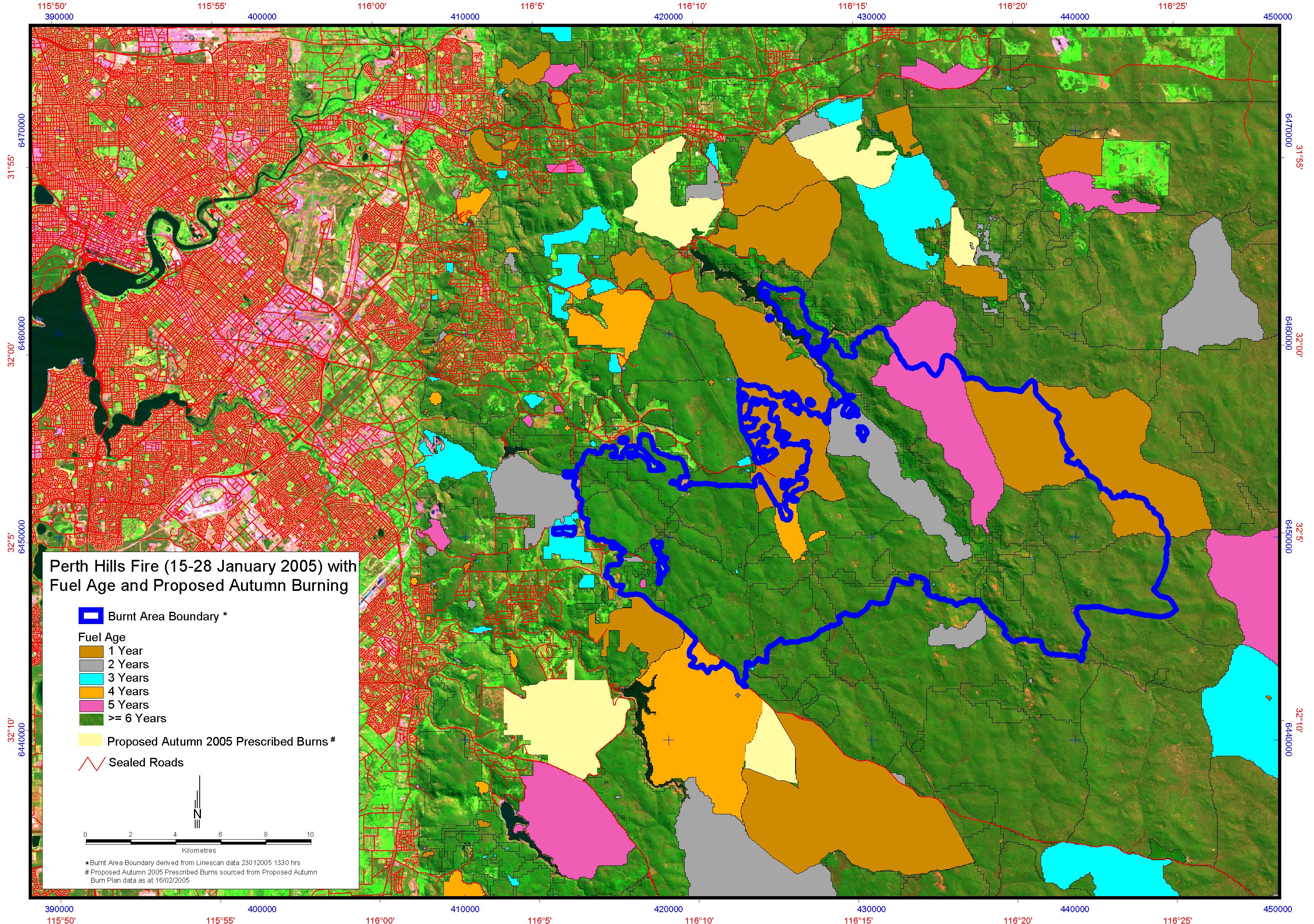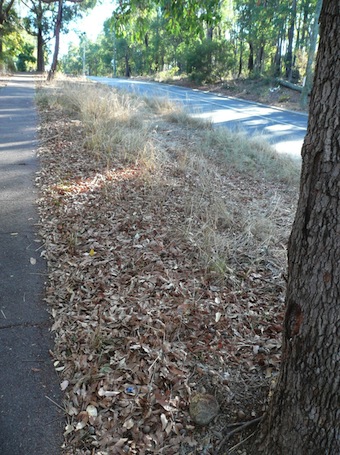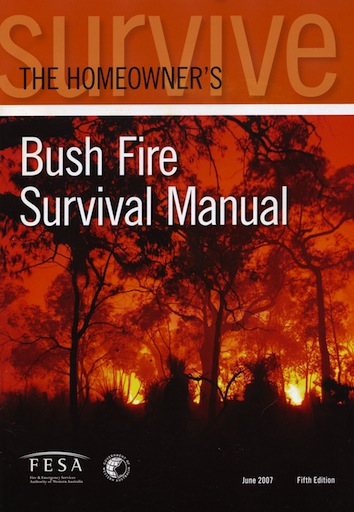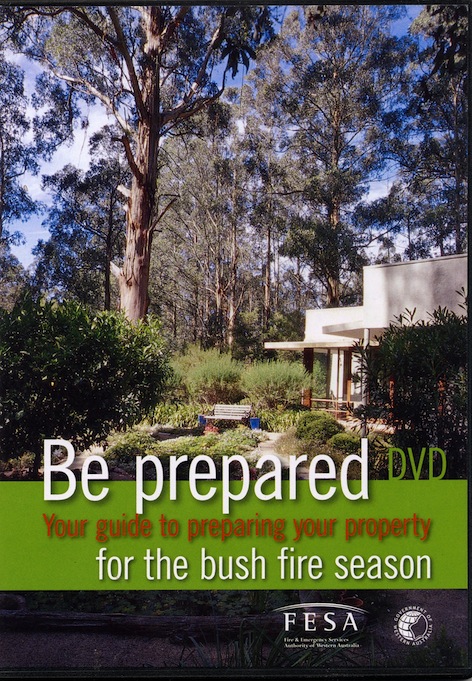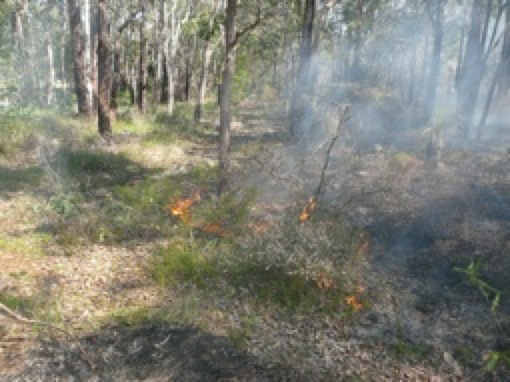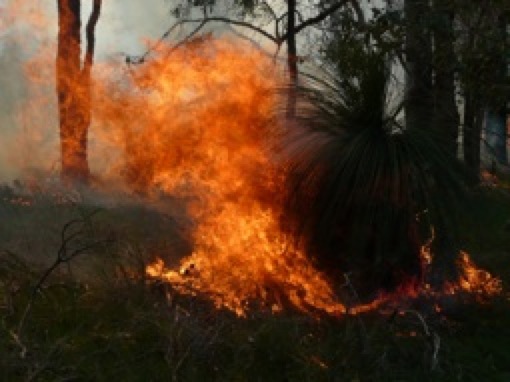Focus on Fire Management in the Perth Hills
This page covers several aspects of the fire management situation in the Perth Hills region, which stretches approximately from Stoneville down to Jarrahdale. It was written just after the 2005 Hills bushfire when the forest managing agency was CALM.
Past Bad Decisions Coming Home to Roost. This is What We Have Been Warning About!
Past decisions to defer fuel reduction burns in our forests are coming home to roost. The recent Hills bushfire just east of Perth burnt an area of about 27,000 hectares, perilously close to Perth suburbs. It “cooked” a large area of native forest, destroyed the Beraking pine plantation, threatened water quality in the Mundaring Weir and Canning Dam, blanketed the city in smoke for days, probably cost in excess of $10 million to suppress and caused enormous stress and anxiety. Note that we continue to refer to CALM as the agency involved as that was its title at the time of the fire.
To give Perth people an idea of the extent of this fire, 27,000 hectares would cover an area from Scarborough to Guildford in the north down to Ferndale and across to Fremantle in the south.
The Hills fire came on top of severe recent fire in the Yanchep National Park and an even larger wildfire at Mt Cooke in 2003. These fires were all inevitable because of past decisions to defer necessary fuel reduction burns. Why were the burns deferred? There are several reasons:
- Objections to the occasional smoke intrusions into urban areas, resulting in onerous restrictions on CALM burning activities imposed by politicians and environmental authorities.
- Diminished CALM resources on the ground for carrying out fuel reduction burning.
- A change in CALM’s burning policy, away from large burns to smaller “mosaic style” burns that take more resources for less result in terms of fuel reduction.
- Increased internal restrictions on CALM’s burning imposed by environmentalists with unrealistic and unproven ideas about biodiversity protection.
Perth Narrowly Avoided a Canberra-Style Disaster!
Now that the Hills fire has been put to bed, it is time to learn what we can from the disaster. And a disaster it was – for the forest- but also very nearly for large numbers of Perth urban residents as well. Nearly 30,000 hectares of forest “cooked”, unknown numbers of wildlife perished and pollution by ash of two of our vital metropolitan catchments.
Although the weather conditions were severe at the time, they were not by any means extreme. How many people remember the 130 km/hr winds that accompanied the passage of Cyclone Alby in 1978? Make no mistake, that can, and will, happen again. If there had been cyclonic winds like that in January 2005 we would have had an Ash Wednesday situation in the West. And why didn’t we have a disaster in 1978? Because the fuel reduction burning programs of the then Forests Department prevented it.
Today, the community and the forests are in a much more perilous situation than in 1978 because CALM has been unable to maintain that level of burning due to lack of resources, over-strict requirements for smoke control, difficult seasonal conditions and a change to much smaller average size burns. The latter is due to unsubstantiated claims that the previous burning program could have an adverse impact on biodiversity.
When we look at the map of the Hills fire in relation to fuel age, shown below, two striking impressions emerge:
- The major run of the fire towards the Roleystone-Kelmscott-Armadale communities was stopped when it entered an area of forest where recent fuel reduction burning had occurred. Here suppression measures were at last successful. If this fuel-reduced buffer had not been in place, and the wind had stayed in the east a little longer, the fire would have come over the Scarp and entered suburbia. The devastation to property would have been enormous and who knows what risks there would have been to human lives.
- A similar potentially dangerous situation existed in the Pickering Brook area, but there was no deep burning buffer, as there was further south, that could have allowed firefighters to contain the fire. Only a huge effort by CALM and the bush fire brigades under FESA, prevented large-scale urban conflagration.
The main fire area in the Mundaring Weir catchment burned in 12 year old fuel. With fuel loads of this magnitude, it was always going to be a difficult task to control the fire, even under mild weather conditions. It is scandalous that this heavy fuel situation was allowed to develop so close to built up areas.
In the map above, the dark blue line shows the final fire boundary. The built up urban area is clearly shown on the left with red marking the road network and pale green cleared areas ending at the Darling Scarp, slightly to the left of centre in the map. The dark green area is forested land, and within the dark green envelope the dark brown, grey, light blue, light brown and pink patches show the years since last burn. For all practical purposes, all the dark green area to the right of the Scarp has a fuel age older than 6 years, and much of it was 12 years old. Some parts were as much as 30 years old.
The fires were lit about the centre of the map and ran due west (a later lightning strike further east joined up with the main fire). The western fire boundary, where it was finally controlled, can be seen to lie along the edge of a large and deep area burnt one year to 4 years ago (grey, light blue, dark brown and light brown areas). The threat to Armadale, Kelmscott, Roleystone and even Gosnells and suburbs further in is obvious.
Large fuel reduction burns like this do not necessarily stop a running fire – they will under mild to moderate weather conditions – but they do reduce fire intensity to a point where effective suppression is possible. Of course, when fire intensity is reduced, the damage to the forest ecosystem is also reduced.
It will be claimed by some that such a wildfire would not penetrate into suburbia because the lawns and roads would act as effective firebreaks. Under mild weather conditions this is true, but under severe and extreme weather conditions the Canberra disaster has shown that houses will burn, ignited by a rain of burning embers. An intense wildfire can throw such embers several kilometres ahead of the main fire front.
What many people do not realise is that the fashion for using native vegetation and woodchip mulches in their gardens has introduced highly inflammable material into urban areas. Much of our native flora contains essential oils in their foliage, which aid fire spread in the natural environment, and the same happens wherever the plants grow.
What Lessons Should We Learn?
- It is abundantly clear that Perth escaped a major urban fire disaster by the skin of its teeth. It is also more obvious than ever that it is fuel reduction burning, if correctly designed and carried out, that is the vital factor that gives us the capacity to prevent such a disaster. Moreover, this fire event has again demonstrated that the small-scale patchy burns of a few hundred hectares advocated by the armchair theorists to “protect biodiversity” are inadequate and cannot provide the depth of protection that is given by broadscale burns of 5-10,000 hectares arranged in strips about 5 km in depth. Experience has shown that burns of this size are effective in slowing down major fire runs and allowing effective suppression measures by ground crews. One of the reasons that deep burns are necessary is that a low intensity burn usually results in only about 70% of the area actually being burnt by fire. The slow moving, low intensity fires trickle about, leaving wildlife time to escape to unburnt islands.
- We should never allow this situation, of large areas of long-unburnt forest, some of it 30 years since last burn, to occur again so close to developed areas and in our vital water catchment areas. Jarrah forest of this class should be kept to a maximum fuel age of 5 years in the west and up to 8 years in the eastern zone.
- City people have to learn to tolerate occasional smoke events from prescribed burns. The brief exposure to smoke generated by a fuel reduction burn is inconvenient for urban residents, but vastly less than the exposure caused by the amount of smoke that was generated by the Hills fire – which blanketed the city for several days. Urban residents are just going to have to get used to bit more smoke in autumn and spring in order to avoid much more smoke, and the property destruction that goes with it, in midsummer. In view of the oft-expressed opinion that smoke from fuel reduction burns causes increased hospital admission of people with respiratory problems, it was heartening to see a Health Department official on TV stating that this did not occur during the Hills fire.
- Another lesson we can learn from the Hills fire is that in large fires like this the normal fire detection systems, the spotter aircraft and lookout towers, are ineffective due to the smoke haze. The airborne infrared scanner brought in from NSW was a most useful tool, enabling accurate information on active fire areas and hopovers to be obtained through the smoke. Unfortunately, this technology is extremely expensive and it is hardly justified for Western Australia to invest in it for the relatively infrequent occasions when it is needed. It is time for a nationally coordinated approach, with all States and Territories sharing the cost of a unit that could be moved around as required.
How Do we Avoid Another Fire Like This?
There are two basic changes we must make, if we are to avoid this situation arising again. Firstly, CALM must carry out much more low intensity burning in all our forests, and the planning of the burning operations must be altered away from small “pocket handkerchief” style burns in favour of large, east-west oriented burns sited to intercept major fire runs. It is the major fires that cause 90% of the fire damage. Forest fuel accumulation must be managed so that the levels for jarrah and karri forest do not exceed 8 tonnes/ha for jarrah and about 16 tonnes/ha for karri. Heavy fuels should occur only on about 20 percent of the forest area.
The Bushfire Front is well aware that CALM feels constrained in its burn planning by the existence of large areas of regenerated forest. In the jarrah forest, it is quite possible to reduce the period of fire protection to less than 10 years, down from the present 15-20 years, by adopting techniques such as night burning for the critical first burn. In karri forest the first burn after regeneration is much more difficult. However, it is made relatively easy if the regrowth has been thinned first. CALM, and the Forest Products Commission, must give greater emphasis to keeping an adequate thinning program going in regrowth karri forests.
Mopping up after a burn an essential activity
Secondly, the on-ground fire suppression forces must be expanded significantly to enable faster attack by a dispersed force of highly trained and well-equipped firefighters. In other words WA must return to well-proven strategies that have served us well in the past.
The effort directed by CALM into this fire again demonstrated how slender its firefighting resources are. All fire crews but a skeleton staff left in the south were engaged on this fire. If the lightning storms that occurred during the fire had extended further south and lit fires south of the Blackwood River, they would have been left to run. The consequences of that might have been truly catastrophic. Furthermore, at one stage, CALM had to withdraw all its crews from the eastern sections of the fire, and could not attack the lightning strike from the ground, in order to assist brigades in the Pickering Brook area, where a major breakout into the outer suburbs was feared.
Although the Hills fire had assistance from a veritable fleet of aircraft, it was the ground crews who actually were responsible for controlling the fire. It was once again shown that high technology, while making good theatre, is helpful only at the margins of large forest fires. The cost of all this technological effort was enormous. The fire is estimated to have cost the State about $10 million. This tab is picked up by State Treasury, which means there is $10 million less this year that we can spend on education or health. If one offsets this huge cost of fire suppression against perhaps $50,000 to carry out additional fuel reduction burning in the area where the fire occurred, it is easy to see that the State has made a very bad bargain indeed in relying on fire suppression instead of fire prevention measures.
Reliance on fire suppression and neglecting forest fuel management has been shown, over and over again, in NSW, Victoria and in the USA, to be a failed strategy. Why has Western Australia continued down this dangerous path?
In spite of a magnificent effort on the part of the volunteer brigades, and CALM throwing virtually all its resources into the battle, we simply did not have enough feet on the ground. We should always bear in mind that the high fuel loads mean more dangerous working conditions for firefighters, and it is hardly fair to ask CALM staff and volunteer brigade members to face steadily increasing risks in attempting to extinguish forest fires.
The solution that the State must now follow is to provide CALM with more full time fire crews. The BFF estimates that at least 20 more fully equipped 6-man permanent fire crews are needed to provide a reasonable level of suppression force for the whole south west of the state. This extra manpower would also enable CALM to more readily meet its burning targets and make inroads to the large backlog of deferred burns that has built up in recent years. It is much more cost-effective for the State to employ more people in rural areas to manage forest fuels and provide an effective ground suppression force than to hire very expensive aircraft, which are ineffective in very severe fire weather conditions anyway.
Rural people have a justifiable claim that the State’s leaders have sold them down the drain over the last 20 years. It is totally wrong to reduce the fire management capacity of the State agency responsible for managing forests in the south west, as has happened, while at the same time allowing forest fuel levels to rise, making firefighting more dangerous and fires more difficult to control, and then placing more reliance on the volunteer bush fire brigades to assist with fire suppression in forests.
It is time country people stood up and said: Enough! We want our share of resources and we will no longer bear the burden of increased fire hazards just to satisfy the desires of inner city environmentalists – amateur land managers – who are not themselves threatened by bushfires.
2. Improving Bush Fire Management in the Perth Hills Region
All who live in the Hills are well aware that they are living in an area with a high risk of bushfires. The 2008 Parkerville fire was a good example of the sort of fire that occurs regularly in the region. Every year we see homes and infrastructure lost, firefighters’ and residents’ lives put at risk and much public money expended to control these fires. Just because it hasn’t happened near you yet does not mean you will escape.
Most, if not all, landholders will have received copies of the FESA DVD Be Prepared, as well as A Bushfire Survival Manual (2007 edition) and several supporting leaflets. You would perhaps think that if everyone complied with the FESA recommendations then the bush fire problem would be much reduced. Sadly, this is not the case.
Firstly, many landholders do not follow the advice provided in these FESA materials. They are putting themselves, their families and their neighbours at risk by not clearing away highly flammable material around their homes. They are at a especially high risk if they adjoin areas of native bush that are not regularly burned to reduce the fuel. They are also making fire suppression by the volunteer bush fire brigades (BFBs) much more difficult and more dangerous.
Secondly, the FESA advice is mainly oriented to saving lives and property (worthy enough aims!) but does not address the fundamental issue of keeping bushfire fuels to a minimum and so making firefighting much easier and much safer. Shire Councils are concerned that firebreaks are installed each year, but remain unconcerned about the heavy fuel that may be inside the firebreak. Given that fires are going to happen, whether we like it or not, it is the condition of that fuel that is critical to the outcomes from a wildfire. Far too much reliance is placed on fire suppression alone, an approach that has demonstrably failed everywhere it has been relied upon.
Can YOU do anything about this? Yes YOU can!
The Issue
It’s not just a matter of the 20 metre fringe around a house that needs attention, nor is it a matter of making sure the firebreak notices are complied with. What needs to happen is that all parties – the Shire Council, Bush Fire Brigades and landholders – need to accept that the amount of fuel available for wild fires needs to be actively managed over the whole region to keep them at a low level. Fire intensity is directly related to the amount of fuel available. Low fuel levels mean mild fire intensity, easy controllability and minimal damage. High fuel levels inevitably mean high fire intensity, and, under severe fire weather conditions, an extreme “blow-up” situation, this will certainly result in severe property losses, and perhaps even losses of life.
Too much faith is placed in firebreaks. They are only effective in stopping a fire if the fire is small and of low intensity. The only way to ensure a summer wild fire is of low intensity is to have low fuel levels.
What do we mean by “low fuel levels”? In the jarrah forest of the Perth Hills this means that the bush should be burned under mild weather conditions about every 4-6 years.
How Current Fashions are Increasing Fire Hazards
Over the past 20 years or so there has been a concentrated campaign by some parties to convince landholders that they should not use exotic plants in their gardens and to change to native plants, partly because they generally do better than exotics and partly because they are reputed to use less water. It has got to the stage where one is made to feel un-Australian unless one adopts this mantra.
Unfortunately, the advocates of this approach forget one vital thing: virtually all native plants are very flammable. Nature has “designed them to burn”. Some are worse than others in this respect, of course. For example, most members of the family Myrtaceae (which includes the eucalypts) have foliage containing essential oils that are highly flammable. Under severe fire weather conditions, these plants almost explode at the advance of a high intensity wild fire.
A related problem is the widespread use of woody mulches to reduce water loss from the soil around garden beds. They surely do reduce water loss, but when wildfires come through, accompanied by high winds as they usually are, these woody mulch beds create devastating ember showers that can overwhelm a house (and firefighters!). This was convincingly demonstrated in the 2003 Canberra fire disaster.
Road verges in this condition can also generate ember showers!
Aversion of urban populations to smoke from fuel reduction burns is another fashion that is increasing fire hazards in the Perth Hills. Our website contains more information on the smoke issue.
Smoke from burning on private land is a relatively small, localised matter. A much more serious situation applies to Crown Land to the east of the Hills district that is managed by CALM/DEC. Forest managers have put in place complex procedures to minimise the risk of large smoke clouds drifting over the metropolitan area, but sometimes unforeseen changes in wind direction do move smoke over Perth. The issue has become worse in the last 20 years due to urban expansion. Over that time heavy political pressure has been placed on DEC (and CALM before it) to avoid ANY smoke over Perth. The result has been continual postponement of burns and a serious build up of fuels in forests adjoining the Perth Hills. See our previous account of the January 2005 Perth Hills fire for more information on this aspect.
In other words, the desire of suburbia for clear skies unsullied by smoke is greatly increasing the risk that Hills residents will suffer a devastating wild fire coming out of Crown Land.
How to Reduce Fire Hazards
Firstly, follow the advice of FESA in respect of the immediate surroundings of buildings. There is sound advice in the Homeowner’s Bush Fire Survival Manual (fifth edition June 2007).
If starting a new house, design it so that it does not provide places in its structure for firebrands to lodge and start it burning, and plan the garden to have only poorly flammable vegetation within at least 20 metres (preferably more) of buildings. Ideally, your house should be able to survive a wild fire unaided. A well maintained lawn is an ideal “last ditch” firebreak, but they do use a lot of water. Gravel drives are also good.
Then, in existing properties, do these things:
* Prune off lower branches of highly inflammable trees, such as conifers, to a height of at least 4 metres. This breaks the “fuel ladder” that enables fire to rapidly climb into the tree crowns.
* Clean out gutters at about monthly intervals during summer. Leaves are shed throughout summer by all native trees and most exotics. Gutters rapidly accumulate enough fuel to set fire to your roof.
* Keep the woodheap at least 30 metres from the house.
* Before the restricted burning season starts, which is about 15 October (actual times available from your Shire Council) clean up all accumulations of leaf litter and dead shrubs. Either take the debris to the rubbish tip or burn small heaps of leaves and twigs. Evenings are best for burning heaps.
* DON’T be put off by the fashionable nonsense about burning litter contributing to greenhouse gases. In Australia, the fixation of CO2 by vegetation and its release a few years later by burning is a cycle that has been going on for millennia. You are NOT adding to the atmospheric CO2 by doing this, merely recycling a bit of CO2 back to where it was before. CO2 is, after all, food for plants.
Carrying Out a Fuel Reduction Burn
If you have extensive areas of native bush, carry out a controlled burn under mild weather conditions. This weather is best in spring, as the ground litter gradually dries out after the winter rains. In the Perth Hills area this can be August to mid September. If a burn is started in mid to late afternoon in the early spring it will almost certainly go out completely in the evening.
A low intensity spring burn in Hills jarrah forest
First, rake a break about one metre in width around any “hollow butt” trees to prevent the trunk from catching fire again and possibly causing the tree to burn down. The same needs to be done to any dead trees that can catch alight. The burn should be lit on the downwind side of the area so that the flames burn quietly back into the wind. FESA is developing guidelines for burning that will assist in planning such a burn.
A dead tree that has caught alight – these can fall at a later time.
Volunteer BFBs may be able to provide assistance with the burn as fuel reduced areas make their task much easier, and much safer, should a wild fire occur there over the next 3-4 years.
Remember, you will need to advise your neighbours about your burn and have a good firebreak around the area to be burnt. Gaining the assistance of your neighbours is also a good way to go. You may need a permit from the Shire fire control officer if the area is large and once the restricted burning season has begun. Always check with your Shire fire control officer first.
If you adjoin a reserve of some sort, find out which agency in which it is vested and put pressure on them to reduce the fuels. It is their legal obligation under the Bush Fires Act to do this.
List of Plants to avoid near your house
* most conifers, but especially Cypress species. Old pine trees that have been well pruned are relatively fire safe.
* native shrubs, especially those of the family Myrtaceae that have oil glands in the foliage. This would include species of Eucalyptus, Leptospermum, and Melaleuca. They are fine in the garden if well away from the house.
* most Acacia species. These are mainly short-lived plants that become scraggly and senescent after about 10-15 years, and so provide a “hung up” source of fuel that greatly increases fire intensity.
* Blackboys, unless the thick dry thatch is burned off or cut off every few years.
You don’t want this to happen alongside your house!
The important thing is to avoid having any flammable tree up against the wall of the house or overhanging the roof.
More desirable plants
* Royena sp, a shrub with dense, thick, dark green leaves with low inflammability
* Northern Hemisphere deciduous trees such as oak, plane, liquidamber, poplar
* Iris
* Agapanthus
* Roses
* Annuals
